Numerical Simulation on the Frequency Response of 3-D Reef–Seawater–Seabed Coupling System Under Seismic Excitation
Abstract
1. Introduction
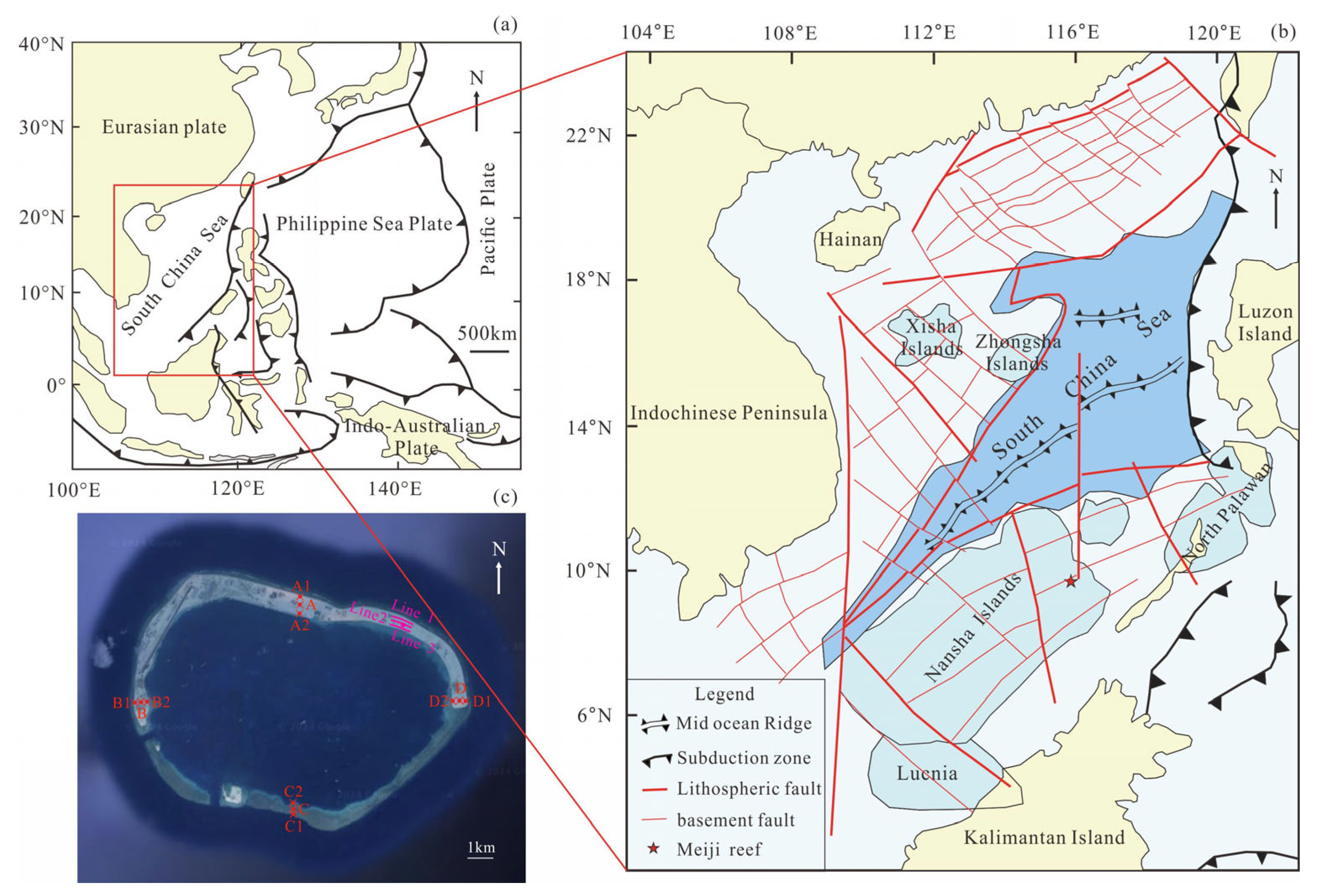
2. Construction of the 3D Model
3. Theoretical Formulation
3.1. Governing Equation of Seawater
3.2. Governing Equation of Coral Reefs
3.3. Governing Equation of Seabed
3.4. Boundary Conditions
3.4.1. Seawater–Air Boundary
3.4.2. Seawater–Reef Boundary
3.4.3. Seawater–Seabed Boundary
3.4.4. Reef–Air Boundary
3.4.5. Reef–Reef Boundary
3.4.6. Reef–Seabed Boundary
4. Numerical Implementation
- (1)
- Model construction. Establish a 3-D model with dimensions of 16 km × 14 km × 2 km based on parameters such as slope angle, reef stratification, lagoon depth, and weathered layer in Section 2 of this paper. The depth of the lagoon water is 0.02 km. The slope angle of the first layer of the reef is 60°, while the other layers are 45°. The thickness of each reef layer from top to bottom is 0.02 km, 0.1 km, 0.42 km, and 0.46 km, respectively. Below the reef is a 1 km thick volcanic bedrock. The outermost layer of the model is a 1 km thick PML, used to simulate the infinite domain (Figure 3).
- (2)
- Physical field and boundary conditions. The detailed physical field and boundary conditions are described in Section 3 of this paper, and all equations are built-in equations in the software.
- (3)
- Parameters. As described in the third section, the coupled model includes the fluid domain, the solid domain, and the saturated porous domain. The fluid domain is seawater, with a density of 1000 kg/m3, acoustic velocity of 1483 m/s, dynamic viscosity of 1 × 10−3 Pa·s, and compressibility of 1/(2.2 × 109) 1/Pa [25,34]. The solid domain is the late Triassic volcanic rock, with a density of 1000 kg/m3, and the P-wave and S-wave velocities are 5000 m/s and 2200 m/s, respectively [17]. The porous domain consists of four layers of reefs, and the parameters are shown in Table 1. Among them, only the permeability cannot be directly obtained. Fortunately, the influence of permeability on the acceleration of the coupled system can be ignored [25]. Therefore, it can be assumed that the permeability of each layer is equal to those of the others [37].
- (4)
- Mesh subdivision. To ensure the accuracy of the calculations, the size of a single grid in the solid and porous domains should be less than one eighth of the wavelength in the corresponding material at the highest frequency [36]. Due to the lack of strong earthquake records in the SCS, and considering that the Fourier spectrum frequencies of the Umbria waves, the Hualian waves, and the Denali waves detected in areas with similar seismic tectonic backgrounds to the SCS are usually below 6 Hz [15], this paper mainly studies the response of Meiji Reef induced by the earthquake at frequencies of 0.1–6.0 Hz. So, the maximum grid size of the seabed should be less than 0.05 km, and the maximum grid size of the reef should be less than 0.02 km. In addition, mesh refinement is conducted in and around the irregular boundaries.
- (5)
- Calculation. The coupled model is solved using the MUMPS solver, and the second-order Lagrange elements are used to ensure accuracy in evaluating the dependent variable in the computational domain of solids and others. The research step is 0.05 Hz between 0.1 and 3.5 Hz, while it is 0.01 Hz between 3.5 and 6.0 Hz, and the relative tolerance is 0.001.
- (6)
- The impact of the weathered layer on the reef. A weathered layer was added to the initial model, keeping all other conditions constant, to obtain the impact of the high-porosity weathered layer on the flat overlying reef. The drilling data show that the acoustic velocity and porosity of the weathered layer are close to those of the first layer of the reef [24], so it is assumed that the parameters of the weathered layer are the same as those of layer 1 of the reef in Table 1.
5. Results and Discussion
5.1. Earthquake-Induced Responses of Reef–Seawater–Seabed System
5.2. The Impact of High-Porosity Weathered Layer on the Overlying Reef Flat
6. Conclusions
- The impact of horizontal seismic excitation on reefs is greater than that of vertical excitation, and the seawater dynamic pressure and reef acceleration caused by earthquakes are mainly concentrated on the side parallel to the direction of seismic wave propagation, while fewer effects occur perpendicular to the direction of the wave propagation.
- The reef near the lagoon is more affected by earthquakes, while the side near the seawater is less affected. During the propagation of seismic waves from bottom to top, the acceleration accumulates in the shallow reef layer, making the shallow reef layer more susceptible impact.
- Compared to saturated porous elastic materials, single-phase linear elastic solid materials would reduce the seismic response of coral reefs and increase the peak frequency to ~0.2 Hz.
- The high-porosity weathered layer increases the seismic response at the reef flat above it. Increasing the depth of the weathered layer, decreasing the area of the weathered layer, and decreasing the weathering degree reduce the seismic response of reefs. By contrast, decreasing the depth of the weathered layer, increasing the area of the weathered layer, and increasing the weathering degree increase the seismic response of reefs.
Author Contributions
Funding
Institutional Review Board Statement
Informed Consent Statement
Data Availability Statement
Conflicts of Interest
References
- Li, G.; Yan, S. The construction of islands and reefs in the South China Sea under the promotion of the “21st Century Maritime Silk Road” initiative. Contemp. World Social. 2018, 156–162. (In Chinese) [Google Scholar] [CrossRef]
- Wang, J.; Ma, L. Research progress of long-term safety theory and technology for reef engineering. Prot. Eng. 2019, 41, 70–78. (In Chinese) [Google Scholar]
- Yu, M.; Zhang, Q. The multiple significance of the construction of islands and reefs in the South China Sea for safeguarding China’s sovereignty and maritime rights and interests in the South China Sea. J. Bound. Ocean Stud. 2019, 4, 34–55. (In Chinese) [Google Scholar]
- Li, L.; Qiu, Q.; Li, Z.; Zhang, P. Tsunami Hazard Assessment in the South China Sea: A Review of Recent Progress and Research Gaps. Sci. China Earth Sci. 2022, 65, 783–809. [Google Scholar] [CrossRef]
- Souter, D.; Planes, S.; Wicquart, J.; Obura, D.; Staub, F. Status of Coral Reefs of the World: 2020. International Coral Reef Initiative. 2021. Available online: https://www.unep.org/resources/status-coral-reefs-world-2020 (accessed on 16 December 2024).
- Fukue, M.; Kawakami, T. Damage to Man-made Islands Caused by the 1995 Hyogo-ken Nanbu Earthquake. Mar. Georesour. Geotechnol. 1996, 14, 237–250. [Google Scholar] [CrossRef]
- Green, R.A.; Olson, S.M.; Cox, B.R.; Rix, G.J.; Rathje, E.; Bachhuber, J.; French, J.; Lasley, S.; Martin, N. Geotechnical Aspects of Failures at Port-Au-Prince Seaport During the 12 January 2010 Haiti Earthquake. Earthq. Spectra 2011, 27, 43–65. [Google Scholar] [CrossRef]
- Brandes, H.G.; Nicholson, P.G.; Robertson, I.N. Liquefaction of Kawaihae Harbor and Other Effects of 2006 Hawai‘i Earthquakes. In Proceedings of the Seventeenth International Offshore and Polar Engineering Conference, Lisbon, Portugal, 1–6 July 2007; Volume 2, pp. 1169–1176. [Google Scholar]
- Lu, B.; Wang, P.; Zhang, G.; Wang, W. Characteristic of regional fractures in South China Sea and its basement tectonic framework. Prog. Geophys. 2015, 30, 1544–1553. (In Chinese) [Google Scholar] [CrossRef]
- Mazur, S.; Green, C.; Stewart, M.G.; Whittaker, J.M.; Williams, S.; Bouatmani, R. Displacement along the Red River Fault Constrained by Extension Estimates and Plate Reconstructions. Tectonics 2012, 31, 2012TC003174. [Google Scholar] [CrossRef]
- Guo, L.; Zhan, W.; Zhang, F.; Zhang, J.; Yao, Y.; Li, J.; Feng, Y.; Chen, M.; Cheng, G. The Influence of Earthquakes on Zhubi Reef in the Nansha Islands of the South China Sea. Acta Oceanol. Sin. 2017, 36, 99–108. [Google Scholar] [CrossRef]
- Tang, Q.; Zhang, J.; Feng, Y.; Li, J.; Yao, Y.; Sun, J.; Zhan, W. Numerical Simulation for Shallow Strata Stability of Coral Reef in the Southwest of Yongshu Reef (South China Sea). J. Ocean Univ. China 2018, 17, 763–772. [Google Scholar] [CrossRef]
- Zhao, W.; Wang, G.; Yin, X.; Zhao, J. Analysis and evaluation of dynamic stability of coral reef in the southwest of Yongshu Reef in Nansha Islands. J. Nat. Disasters 2021, 30, 181–189. (In Chinese) [Google Scholar] [CrossRef]
- Liu, J.; Bao, X.; Li, S.; Zhao, Q.; Wang, F.; Wang, D. Seismic response analysis on reef site considering influence of lagoon. Comput. Aided Eng. 2020, 29, 46–50, 69. (In Chinese) [Google Scholar] [CrossRef]
- Chen, G.; Zhu, X.; Zhao, D.; Liu, J. Nonlinear seismic response characteristics of a coral island site. Chin. J. Geotech. Eng. 2019, 41, 405–413. (In Chinese) [Google Scholar]
- Qiu, Y.; Yin, X.; Wang, G. Seismic response analysis of coral island reef site considering different influencing factors. J. Nat. Disasters 2023, 32, 131–138. (In Chinese) [Google Scholar] [CrossRef]
- Bao, X.; Liu, J.; Wang, F. Influence of Topographic and Geological Features on the Seismic Response of the Reef Site in the South China Sea. J. Mar. Sci. Eng. 2023, 11, 881. [Google Scholar] [CrossRef]
- Bao, X.; Liu, J.; Chen, S.; Wang, P. Seismic Analysis of the Reef-Seawater System: Comparison between 3D and 2D Models. J. Earthq. Eng. 2022, 26, 3109–3122. [Google Scholar] [CrossRef]
- Zhang, Y.; He, K.; Li, X.; Ye, J. Centrifuge Shaking Table Test on the Seismic Dynamics of Revetment Breakwater and a Nearby Aircraft Runway Built on Reclaimed Coral Sand Foundation. J. Mar. Sci. Eng. 2023, 11, 41. [Google Scholar] [CrossRef]
- Zhang, Y.; Ye, J. Seismic dynamics of revetment breakwater built on reclaimed coral sand foundation in the SCS: Insight from 1 g shaking table tests. Bull. Eng. Geol. Environ. 2023, 82, 134. [Google Scholar] [CrossRef]
- He, K.; Ye, J. Physical modeling of the dynamics of a revetment breakwater built on reclaimed coral calcareous sand foundation in the South China Sea-tsunami wave. Bull. Eng. Geol. Environ. 2021, 80, 3315–3330. [Google Scholar] [CrossRef]
- Zhao, M.; Zhang, G.; Wang, P.; Du, X.; Zhang, X. An accurate frequency-domain model for seismic responses of breakwater-seawater-seabed-bedrock system. Ocean Eng. 2020, 197, 106843. [Google Scholar] [CrossRef]
- Luo, Y.; Li, G.; Xu, W.; Cheng, J.; Liu, J.; Yan, W. Characteristics of Quaternary exposure surfaces in Well Nanke-1 and their relationship with sea-level changes. J. Trop. Oceanogr. 2022, 41, 143–157. (In Chinese) [Google Scholar] [CrossRef]
- Xia, S.; Zhang, C.; Cao, J. Ambient Noise Tomography for Coral Islands. Engineering 2023, 25, 182–193. [Google Scholar] [CrossRef]
- Chen, W.; Huang, L.; Xu, L.; Zhao, K.; Wang, Z.; Jeng, D. Numerical Study on the Frequency Response of Offshore Monopile Foundation to Seismic Excitation. Comput. Geotech. 2021, 138, 104342. [Google Scholar] [CrossRef]
- Yi, L.; Deng, C.; Yan, W.; Wu, H.; Zhang, C.; Xu, W.; Su, X.; He, H.; Guo, Z. Neogene–Quaternary Magnetostratigraphy of the Biogenic Reef Sequence of Core NK–1 in Nansha Qundao, South China Sea. Sci. Bull. 2021, 66, 200–203. [Google Scholar] [CrossRef] [PubMed]
- Li, G.; Xu, W.; Luo, Y.; Liu, J.; Zhao, J.; Feng, Y.; Cheng, J.; Sun, Z.; Xiang, R.; Xu, M.; et al. Strontium Isotope Stratigraphy and LA-ICP-MS U-Pb Carbonate Age Constraints on the Cenozoic Tectonic Evolution of the Southern South China Sea. GSA Bull. 2023, 135, 271–285. [Google Scholar] [CrossRef]
- Liu, J.; Webster, J.M.; Salles, T.; Wang, S.; Ma, Y.; Xu, W.; Li, G.; Yan, W. The Formation of Atolls: New Insights from Numerical Simulations. J. Geophys. Res. Earth Surf. 2022, 127, e2022JF006812. [Google Scholar] [CrossRef]
- Zhu, X.; Jia, G.; Tian, Y.; Chen, F.; Li, G.; Xu, W.; Miao, L.; Yan, W. Ancient Hydrocarbon Slicks Recorded by a Coral Atoll in the South China Sea. Chem. Geol. 2023, 619, 121316. [Google Scholar] [CrossRef]
- Bao, X.; Liu, J.; Li, S.; Wang, F. Three-Dimensional Seismic Response Analysis of Zhubi Reef in the South China Sea. Shock Vib. 2021, 2021, 2195304. [Google Scholar] [CrossRef]
- Shapiro, N.M.; Campillo, M.; Stehly, L.; Ritzwoller, M.H. High-Resolution Surface-Wave Tomography from Ambient Seismic Noise. Science 2005, 307, 1615–1618. [Google Scholar] [CrossRef]
- Biot, M.A. Theory of Propagation of Elastic Waves in a Fluid-Saturated Porous Solid. I. Low-Frequency Range. J. Acoust. Soc. Am. 1956, 28, 168–178. [Google Scholar] [CrossRef]
- Zienkiewicz, C.; Chang, C.T.; Bettess, P. Drained, Undrained, Consolidating and Dynamic Behaviour Assumptions in Soils. Geotechnique 1980, 30, 385–395. [Google Scholar] [CrossRef]
- Chen, W.; Wang, Z.; Chen, S.; Ma, J.; Liang, Y. Frequency Response Analysis of Concrete Seawall Including Soil-Structure-Seawater Interaction. Soil Dyn. Earthq. Eng. 2020, 139, 106392. [Google Scholar] [CrossRef]
- Ye, J.; Jeng, D. Three-Dimensional Dynamic Transient Response of a Poro-Elastic Unsaturated Seabed and a Rubble Mound Breakwater Due to Seismic Loading. Soil Dyn. Earthq. Eng. 2013, 44, 14–26. [Google Scholar] [CrossRef]
- De Falco, A.; Mori, M.; Sevieri, G. Simplifed soil-structure interaction models for concrete gravity dams. In Proceedings of the 6th European Conference on Computational Mechanics, 7th European Conference on Computational Fluid Dynamics, Glasgow, UK, 11–15 June 2018; pp. 2269–2280. [Google Scholar]
- Zhong, Y.; Wang, R.; Li, Q.; Wei, H.; Li, X. Research progress on physical and engineering properties of coral reef limestone. Technol. Rev. 2020, 38, 57–70. (In Chinese) [Google Scholar]
- Zhao, H.; Jeng, D.; Liao, C.; Zhu, J. Three-Dimensional Modeling of Wave-Induced Residual Seabed Response Around a Mono-Pile Foundation. Coast. Eng. 2017, 128, 1–21. [Google Scholar] [CrossRef]
- Tian, Y.; Chen, Z.; Huang, W.; Hou, Z.; Yan, W.; Wang, X. P-wave velocity properties and its influencing factors of coral reef limestone in Nansha area. J. Trop. Oceanogr. 2021, 40, 133–141. (In Chinese) [Google Scholar]
- Yu, D.; Ye, J.; Yao, L. Prediction of the Long-Term Settlement of the Structures Built on a Reclaimed Coral Reef Island: An Aircraft Runway. Bull. Eng. Geol. Environ. 2020, 79, 4549–4564. [Google Scholar] [CrossRef]

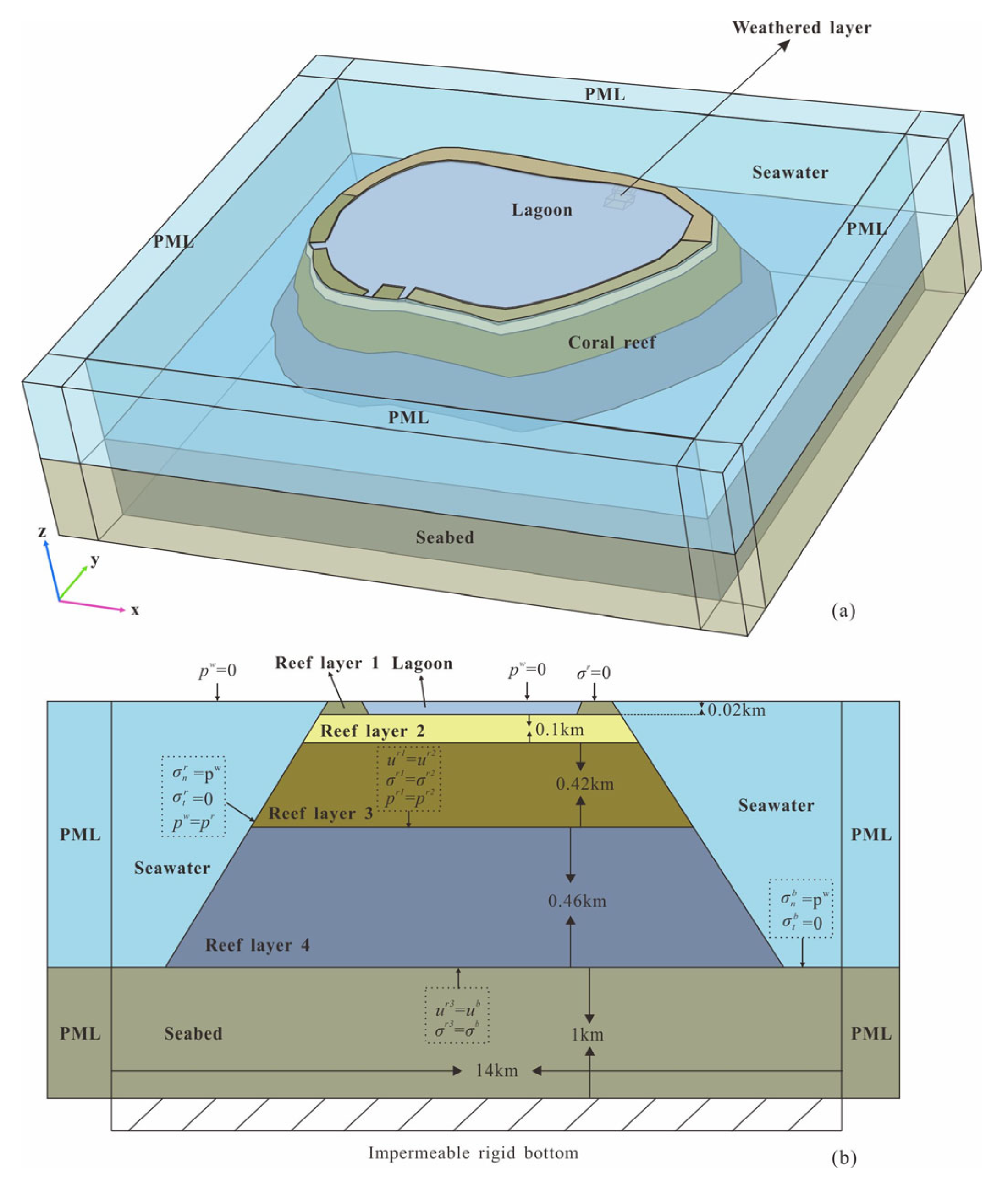
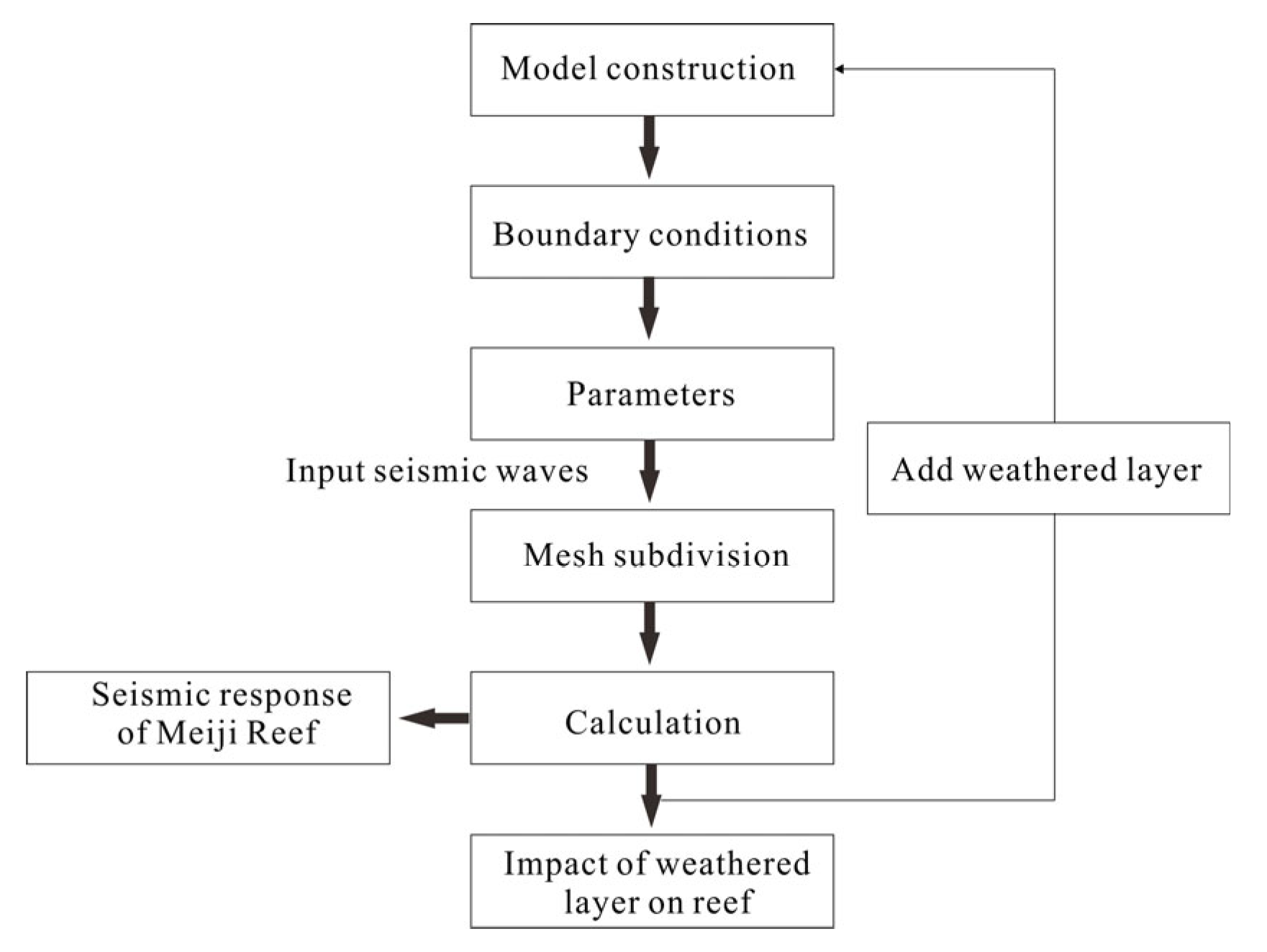
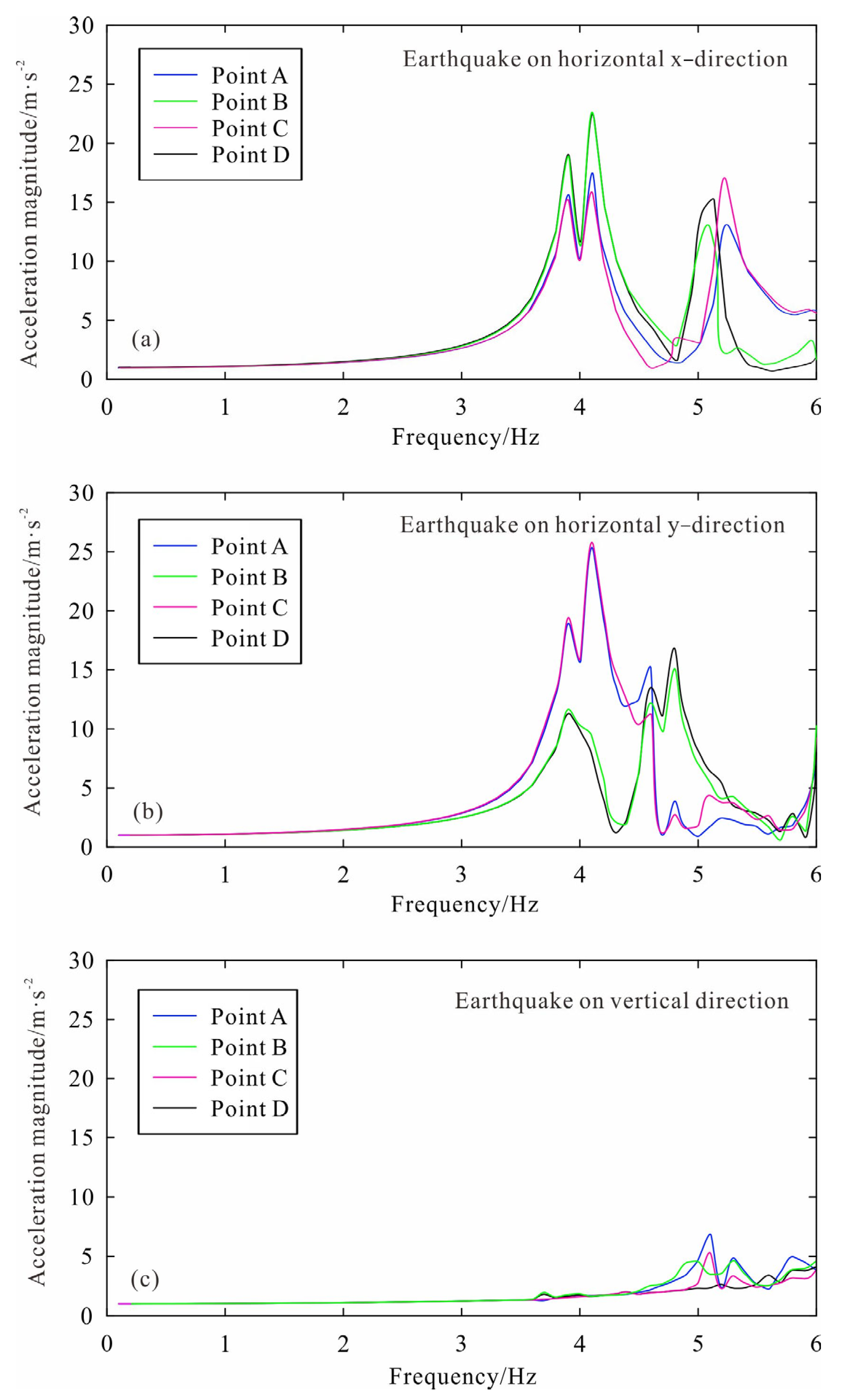
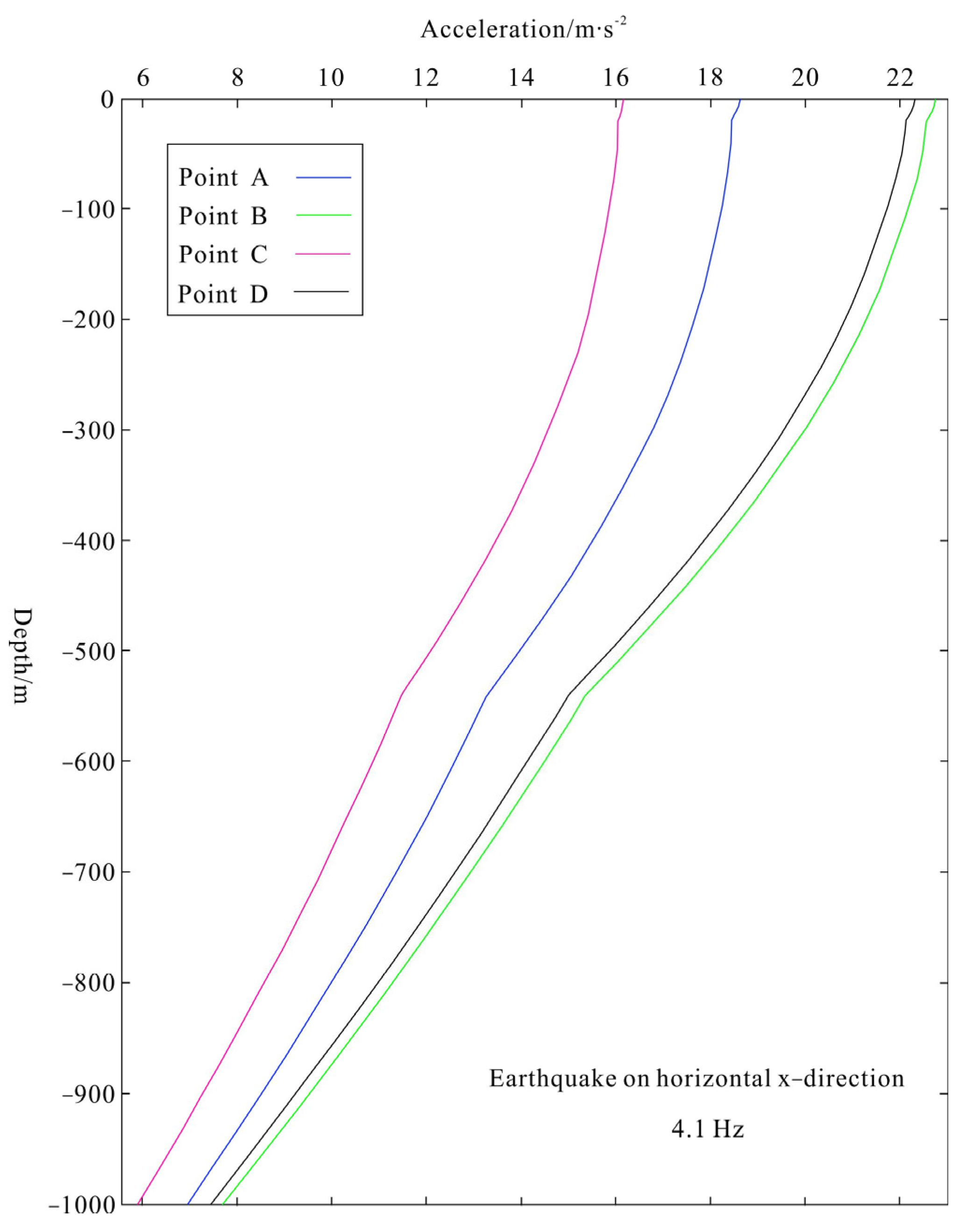
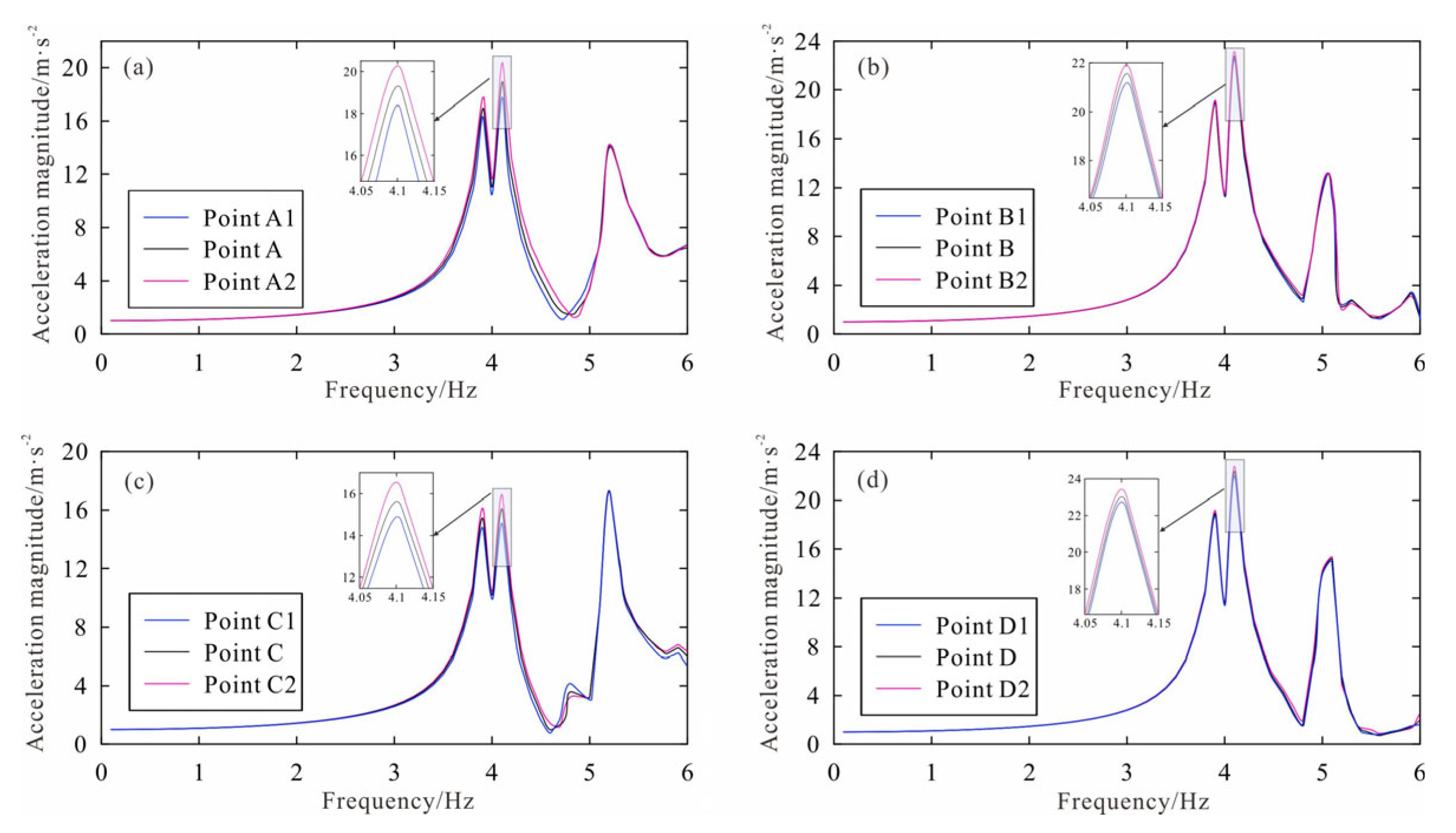
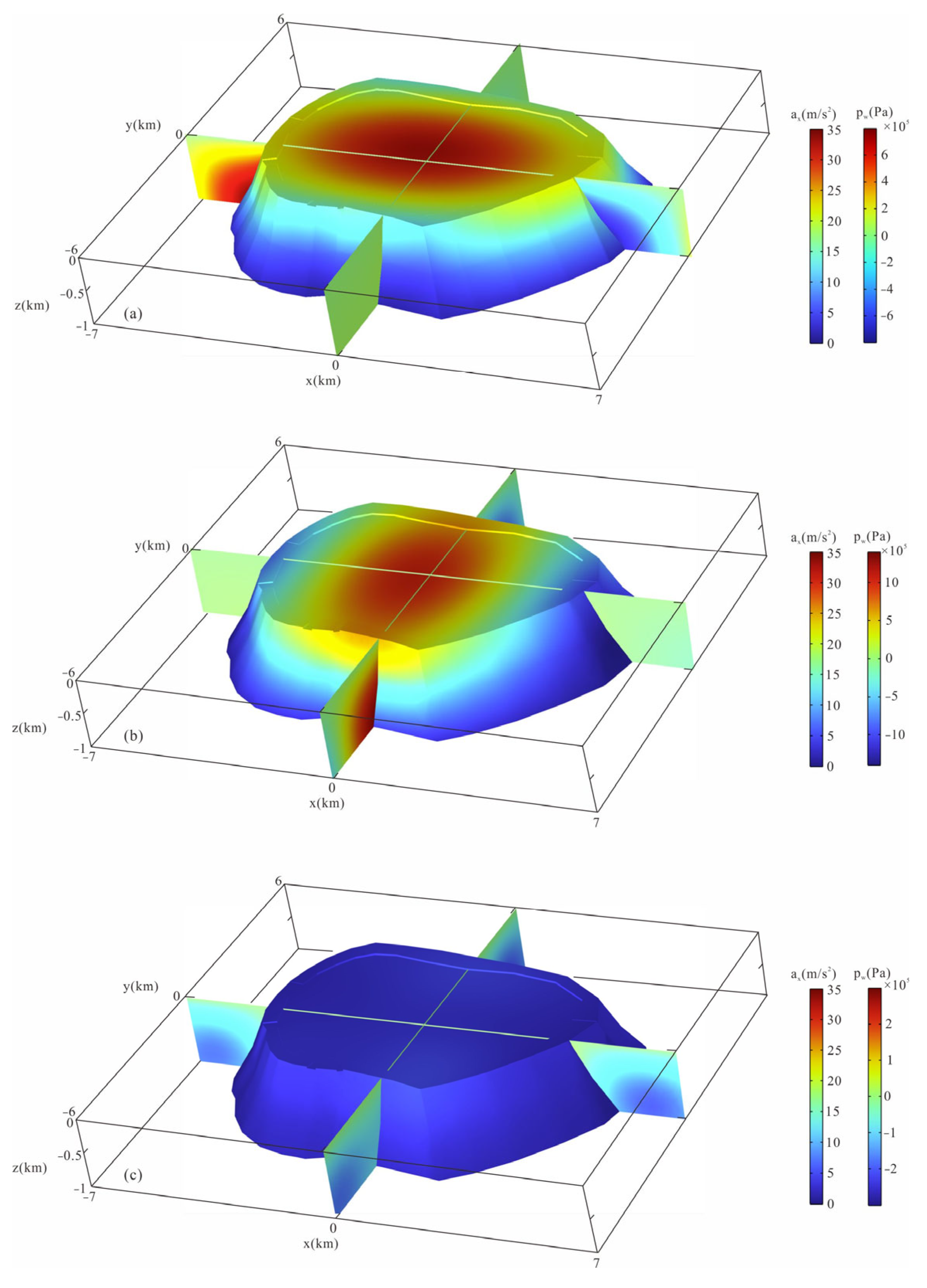
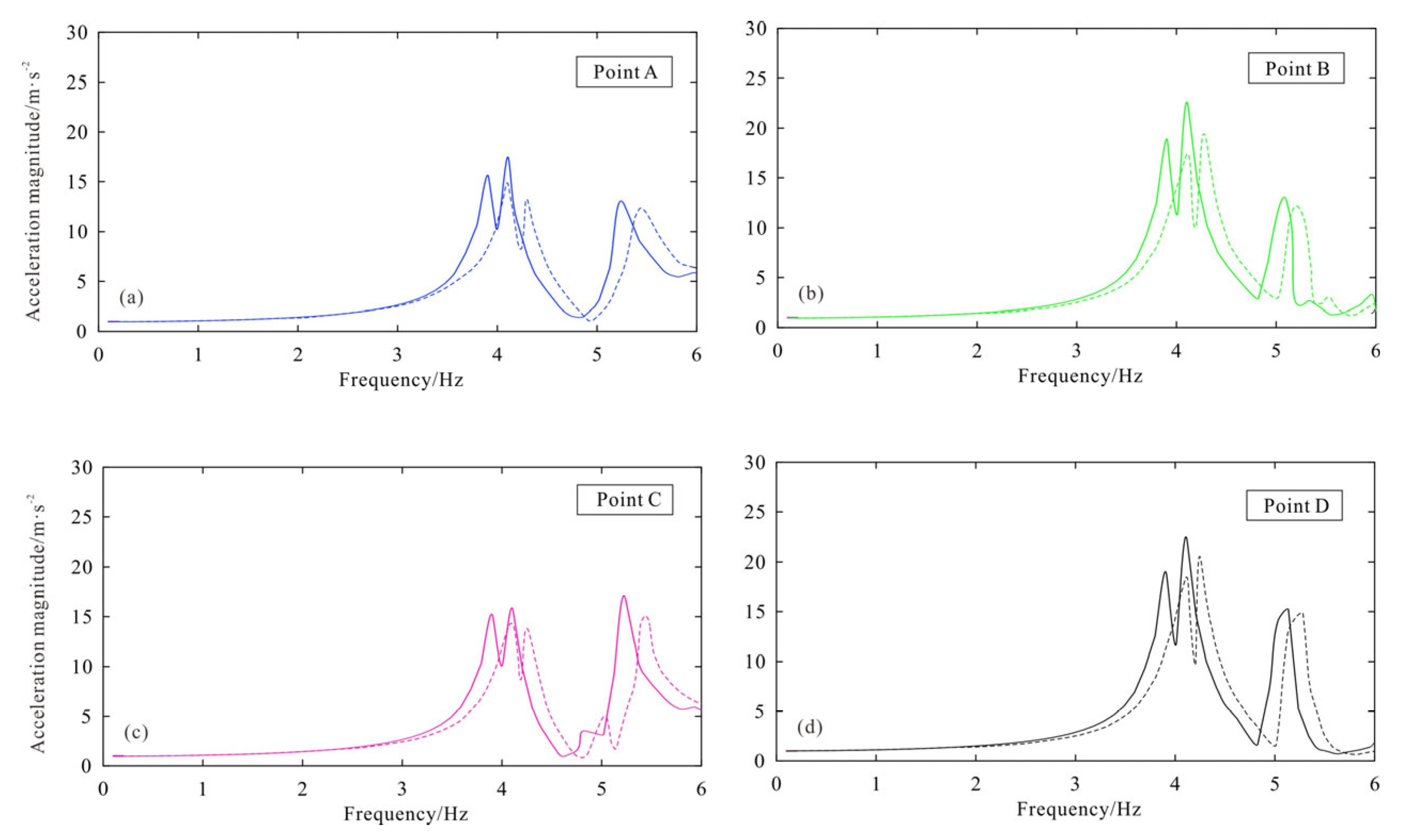
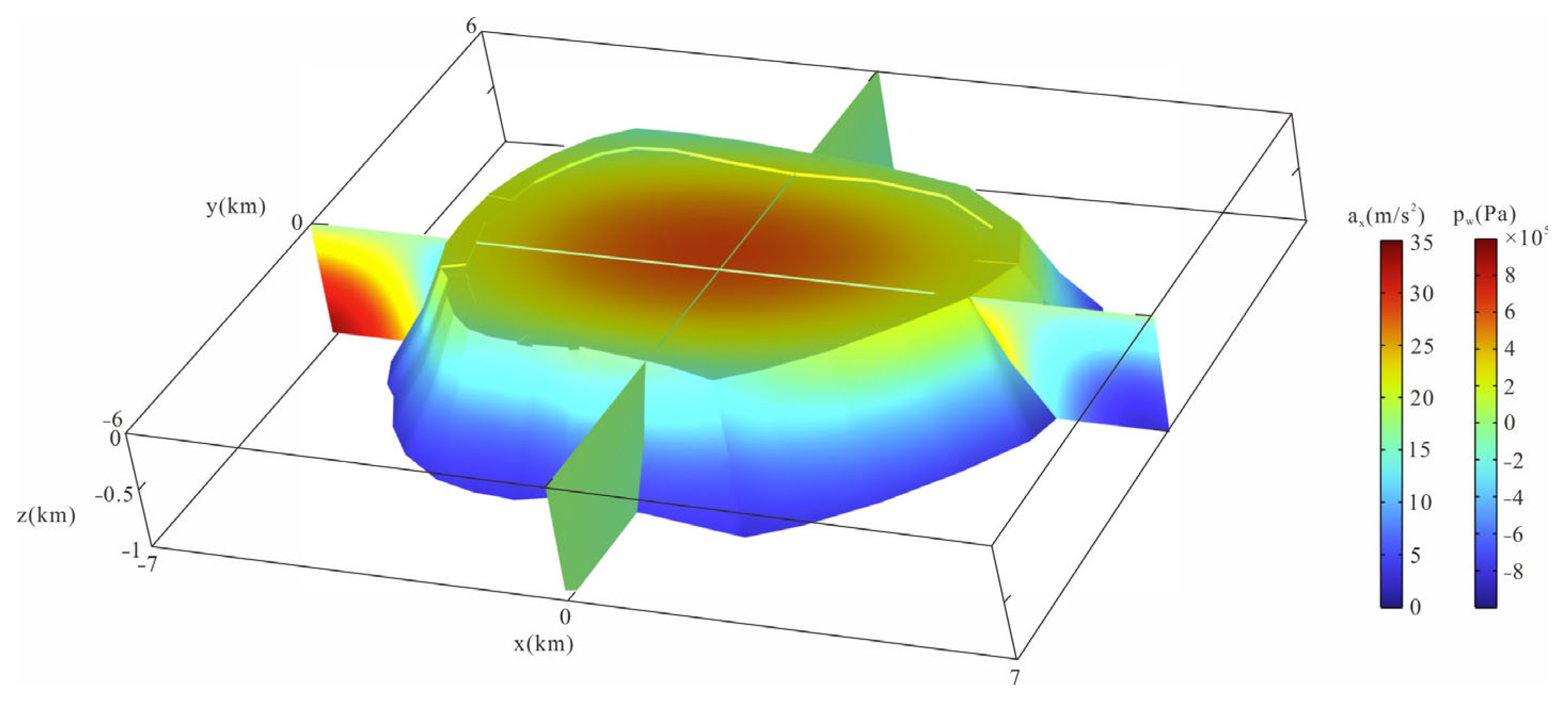
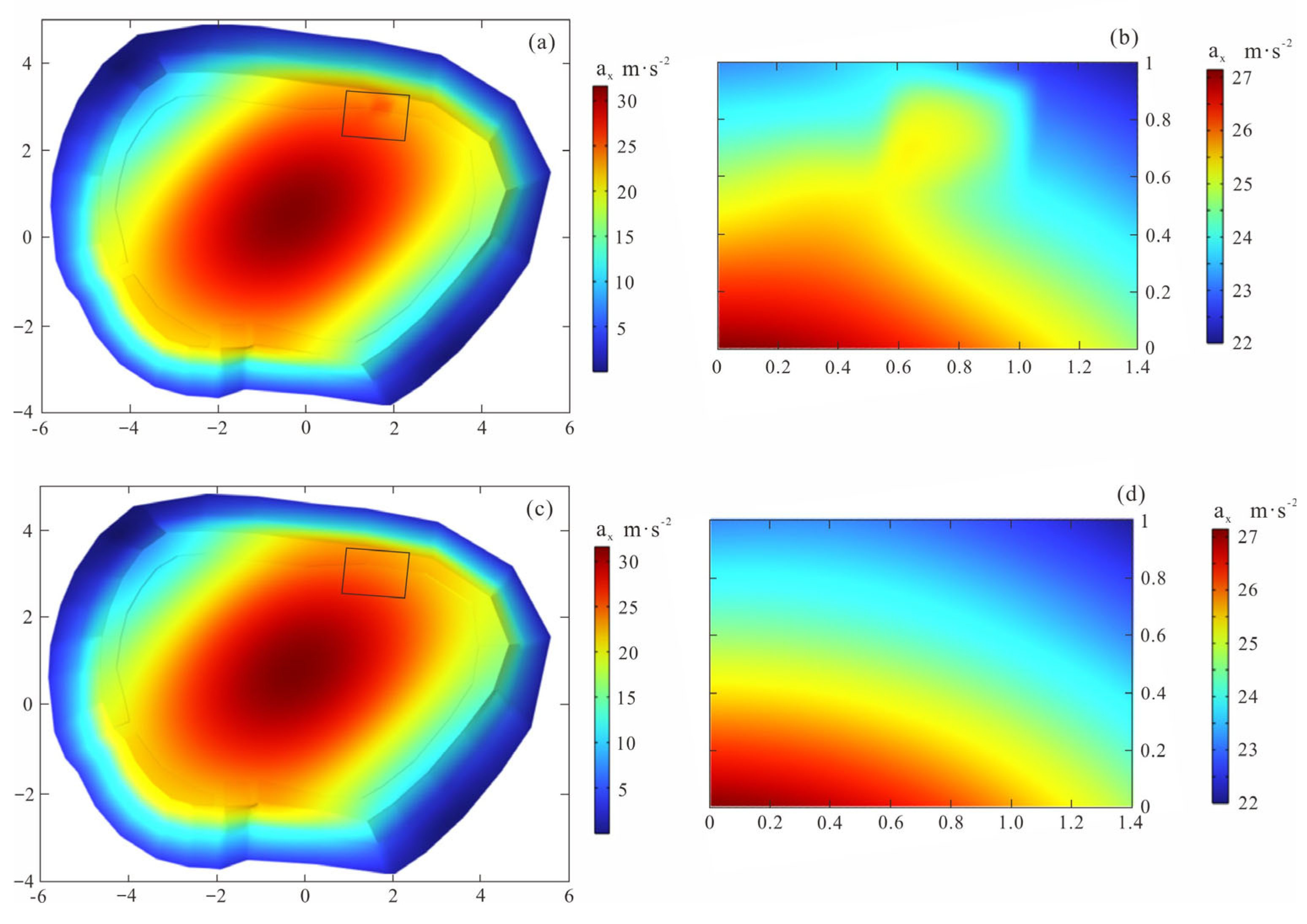
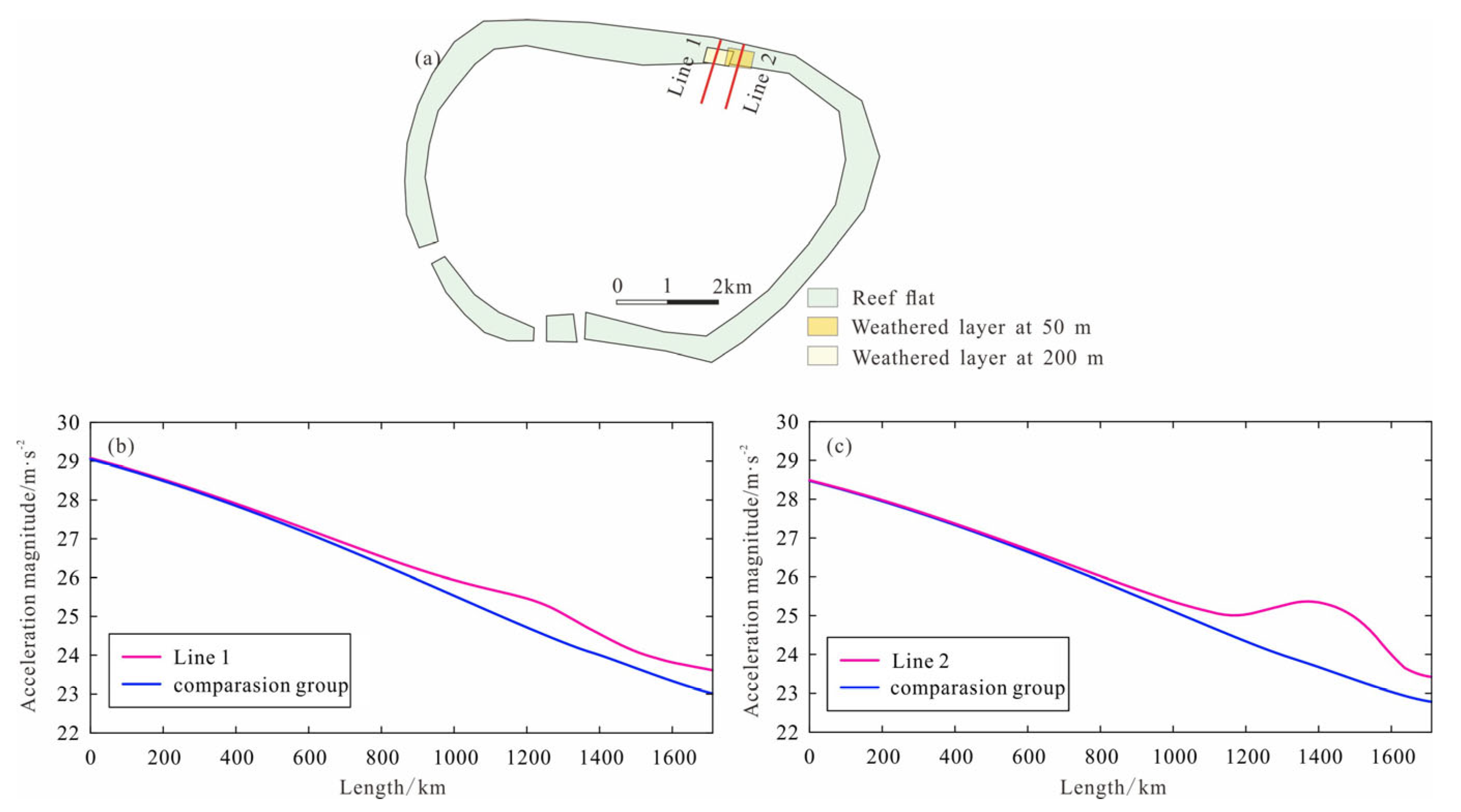
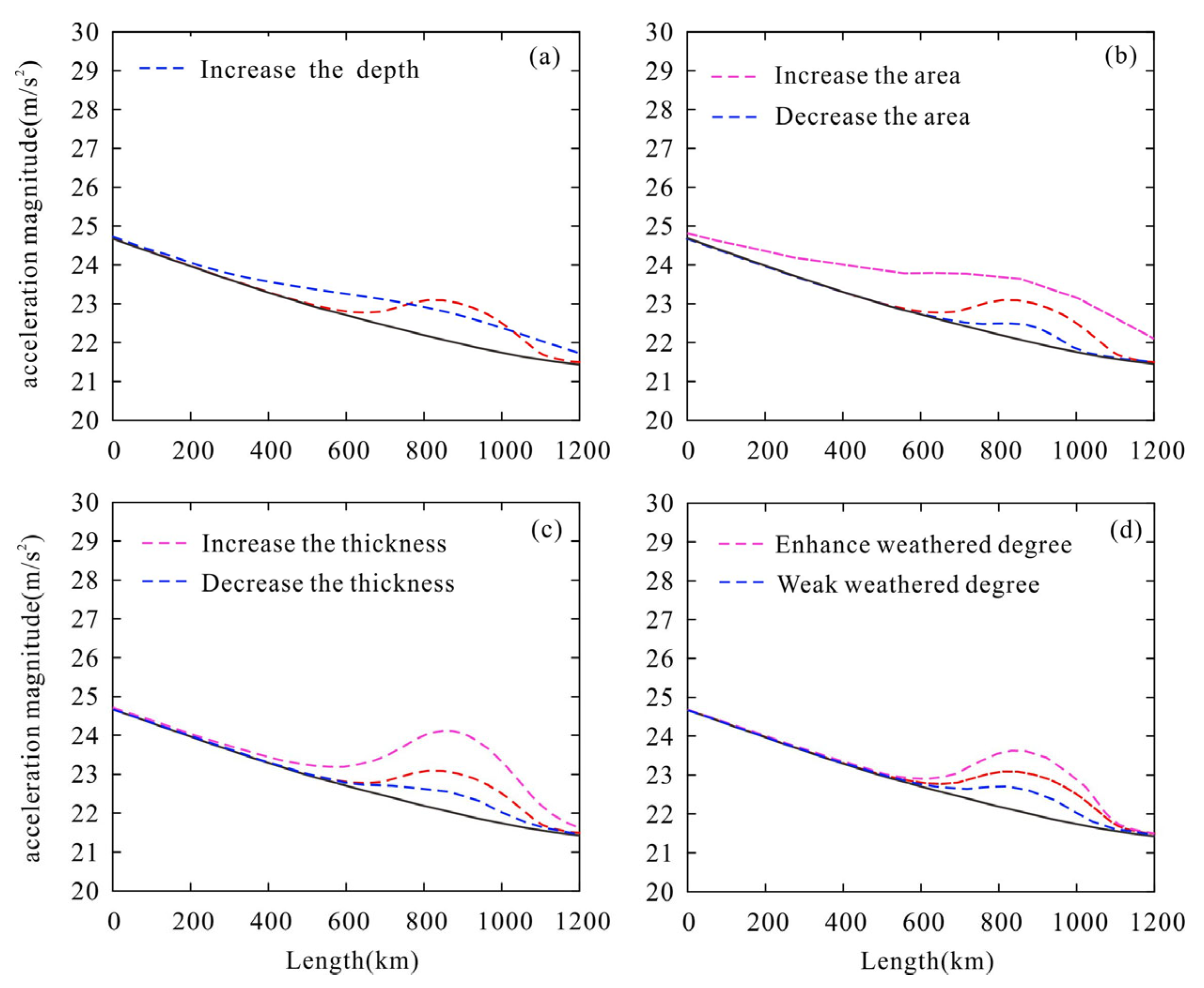
| Parameters | Reef Layer 1 | Reef Layer 2 | Reef Layer 3 | Reef Layer 4 |
|---|---|---|---|---|
| Velocity of S wave vs (m/s) | 500 | 1600 | 1800 | 2200 |
| Velocity of P wave vp (m/s) | 1225 | 4000 | 4485 | 5000 |
| Density (kg/m3) | 2000 | 2300 | 2400 | 2700 |
| Porosity | 0.4 | 0.25 | 0.2 | 0.15 |
| Permeability (m2) | 1 × 10−12 | 1 × 10−12 | 1 × 10−12 | 1 × 10−12 |
| Damping ratio | 0.05 | 0.02 | 0.025 | 0.025 |
| Tortuosity factor | 1.25 | 1.25 | 1.25 | 1.25 |
| Parameters | Enhanced Weathering Degree | Lower Weathering Degree |
|---|---|---|
| Velocity of S wave vs (m/s) | 300 | 1000 |
| Velocity of P wave vp (m/s) | 700 | 2500 |
| Density (kg/m3) | 1500 | 2300 |
| Porosity | 0.7 | 0.2 |
| Permeability (m2) | 1 × 10−12 | 1 × 10−12 |
| Damping ratio | 0.05 | 0.05 |
| Tortuosity factor | 1.25 | 1.25 |
Disclaimer/Publisher’s Note: The statements, opinions and data contained in all publications are solely those of the individual author(s) and contributor(s) and not of MDPI and/or the editor(s). MDPI and/or the editor(s) disclaim responsibility for any injury to people or property resulting from any ideas, methods, instructions or products referred to in the content. |
© 2024 by the authors. Licensee MDPI, Basel, Switzerland. This article is an open access article distributed under the terms and conditions of the Creative Commons Attribution (CC BY) license (https://creativecommons.org/licenses/by/4.0/).
Share and Cite
Yan, L.; Guo, X.; Zhang, X.; Qi, J. Numerical Simulation on the Frequency Response of 3-D Reef–Seawater–Seabed Coupling System Under Seismic Excitation. J. Mar. Sci. Eng. 2024, 12, 2343. https://doi.org/10.3390/jmse12122343
Yan L, Guo X, Zhang X, Qi J. Numerical Simulation on the Frequency Response of 3-D Reef–Seawater–Seabed Coupling System Under Seismic Excitation. Journal of Marine Science and Engineering. 2024; 12(12):2343. https://doi.org/10.3390/jmse12122343
Chicago/Turabian StyleYan, Liwen, Xingwei Guo, Xunhua Zhang, and Jianghao Qi. 2024. "Numerical Simulation on the Frequency Response of 3-D Reef–Seawater–Seabed Coupling System Under Seismic Excitation" Journal of Marine Science and Engineering 12, no. 12: 2343. https://doi.org/10.3390/jmse12122343
APA StyleYan, L., Guo, X., Zhang, X., & Qi, J. (2024). Numerical Simulation on the Frequency Response of 3-D Reef–Seawater–Seabed Coupling System Under Seismic Excitation. Journal of Marine Science and Engineering, 12(12), 2343. https://doi.org/10.3390/jmse12122343






